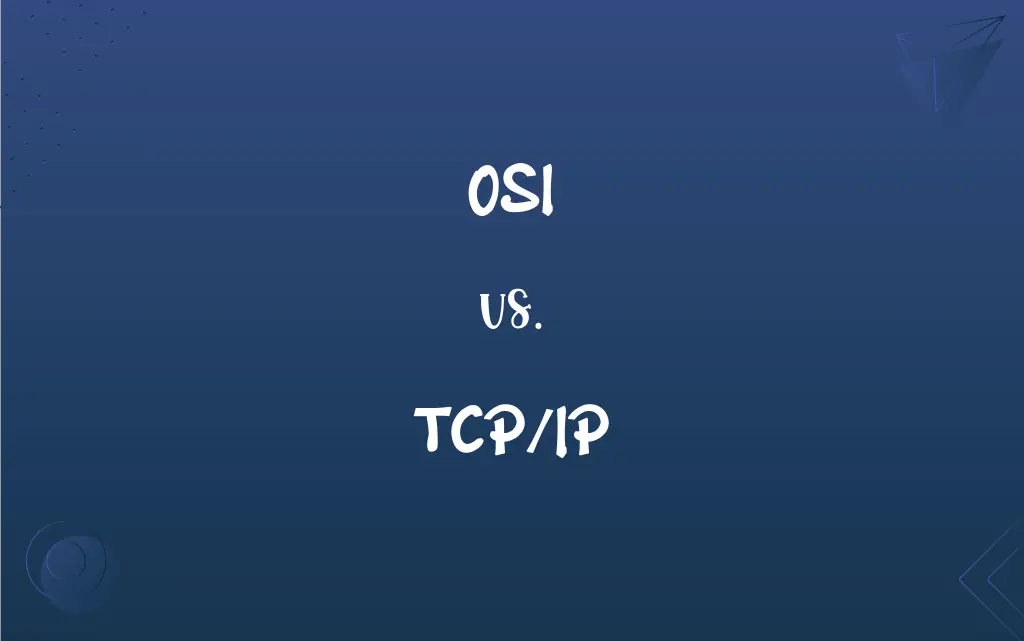OSI vs. TCP/IP: What's the Difference?
Edited by Janet White || By Harlon Moss || Updated on October 7, 2023
OSI is a theoretical 7-layer model to understand network functions. TCP/IP is a practical 4-layer model widely used for internet architecture.

Key Differences
OSI, which stands for Open Systems Interconnection, is a conceptual framework that standardizes the functions of a telecommunication or computing system into seven abstraction layers. In contrast, TCP/IP, which stands for Transmission Control Protocol/Internet Protocol, is a suite of communication protocols used to interconnect network devices on the internet, utilizing a more streamlined 4-layer model.
OSI's model is notably theoretical and is often employed as a guide to understand how different networking protocols interact in a generalized manner. TCP/IP, conversely, was developed by the United States Department of Defense and has been practically implemented in various forms since its inception, demonstrating a hands-on applicability in networking and internet communication.
Each layer in the OSI model focuses on a specific functionality and interacts with the layers immediately above and below it, providing a clear separation of duties. In contrast, the TCP/IP model is known for its pragmatic approach towards network data communication and does not strictly adhere to the segregated layer concept of OSI.
OSI's architecture is prescriptive, with a detailed specification of what each layer should do, offering a universal standard, irrespective of the technological and procedural details. Whereas, TCP/IP is seen to be more flexible and adaptive to real-world situations, often being praised for its ability to accommodate a diverse range of innovative protocols and technologies.
In a nutshell, while OSI offers a theoretical and comprehensive seven-layered model for understanding various network protocols, TCP/IP gives us a practical, widely-adopted, and globally implemented four-layer protocol suite, which has played a pivotal role in shaping the internet as we know it today.
ADVERTISEMENT
Comparison Chart
Layer Count
7 Layers
4 Layers
Development Motive
Conceptual and educational
Practical, developed for ARPANET
Adoption
Not widely adopted in networks
Universally adopted (the basis for the internet)
Protocol Spec
Strictly defined protocols per layer
Protocols can operate across multiple layers
Practical Use
Mainly theoretical and educational
Extensively used in real-world networking
ADVERTISEMENT
OSI and TCP/IP Definitions
OSI
OSI is more of a theoretical model and is not implemented in networks as-is.
Although OSI is commonly known among IT professionals, TCP/IP is typically the implemented protocol suite in networking.
TCP/IP
TCP/IP, standing for Transmission Control Protocol/Internet Protocol, is a suite of communication protocols used to link network devices on the internet.
TCP/IP enables data transmission across diverse network architectures, providing the foundation of internet connectivity.
OSI
OSI, or Open Systems Interconnection, is a conceptual model that standardizes network protocol architecture into seven layers.
Network engineers often refer to the OSI model to troubleshoot network issues systematically.
TCP/IP
TCP/IP protocols are the standard for internet communication, enabling data packet transmission across interconnected networks.
Data packets navigate through the internet using TCP/IP, finding the most efficient path between source and destination.
OSI
OSI provides guidelines for creating and implementing network standards, protocols, and devices.
Network protocol developers utilize the OSI model to ensure interoperability between devices and systems.
TCP/IP
TCP/IP uses a four-layered approach (Link, Internet, Transport, and Application) to manage and facilitate data communication in networks.
The Transport layer in TCP/IP, where TCP resides, ensures reliable data transfer by managing error checking and data retransmission.
OSI
OSI seeks to facilitate multi-system communication, ensuring that different system technologies can communicate.
The OSI model enables computers from different vendors to communicate seamlessly over the network.
TCP/IP
TCP/IP is both a practical and adaptable model developed with a priority on data delivery rather than strict adherence to layers.
The resilience and adaptability of TCP/IP have contributed to its widespread global adoption as the core protocol of the internet.
OSI
OSI divides the network communication process into seven distinct, hierarchical layers, each handling specific tasks.
The Data Link layer of the OSI model ensures error-free data transfer between adjacent network nodes.
TCP/IP
TCP/IP provides the fundamental communication protocols and routing technologies that drive the global internet.
Without TCP/IP, the modern internet, with its capability to relay information between disparate networks, wouldn’t be possible.
FAQs
Is OSI used in practical networking?
Generally, no, it's more of a theoretical model.
Is TCP/IP used in practical networking?
Yes, it's the foundational suite of the internet.
Is OSI specific to any particular network hardware?
No, it's a generic framework applicable to any network.
What does OSI stand for?
Open Systems Interconnection.
How widely adopted is the TCP/IP model?
It's universally adopted and forms the backbone of the internet.
Why was the OSI model developed?
To provide a comprehensive, standardized network architecture framework.
Does OSI define specific protocols?
No, OSI provides a guideline, not specific protocols.
How many layers does the OSI model have?
Seven layers.
Which layer of OSI deals with IP addresses?
The Network layer.
How many layers does the TCP/IP model have?
Four layers.
Can TCP/IP handle multiple protocols?
Yes, it can manage multiple communication protocols.
Which layer of OSI is responsible for establishing, managing, and terminating communication sessions?
The Session layer.
Which model is older, OSI or TCP/IP?
TCP/IP was developed before the OSI model.
Which layer of TCP/IP is responsible for determining routing paths?
The Internet layer.
Can OSI and TCP/IP models be used interchangeably?
Conceptually, yes, for understanding networking, but TCP/IP is predominantly used in practice.
Are OSI and TCP/IP mutually exclusive?
No, understanding OSI often aids in comprehending TCP/IP functionalities.
Is TCP/IP more focused on practicality or theory?
Practicality, it was designed for real-world networking.
Which OSI model layer corresponds to TCP in TCP/IP?
The Transport layer.
What does TCP/IP stand for?
Transmission Control Protocol/Internet Protocol.
Is TCP/IP based on a hierarchical model like OSI?
Yes, but it uses a simpler, four-layer hierarchy.
About Author
Written by
Harlon MossHarlon is a seasoned quality moderator and accomplished content writer for Difference Wiki. An alumnus of the prestigious University of California, he earned his degree in Computer Science. Leveraging his academic background, Harlon brings a meticulous and informed perspective to his work, ensuring content accuracy and excellence.
Edited by
Janet WhiteJanet White has been an esteemed writer and blogger for Difference Wiki. Holding a Master's degree in Science and Medical Journalism from the prestigious Boston University, she has consistently demonstrated her expertise and passion for her field. When she's not immersed in her work, Janet relishes her time exercising, delving into a good book, and cherishing moments with friends and family.































































